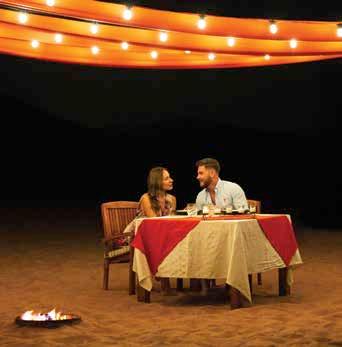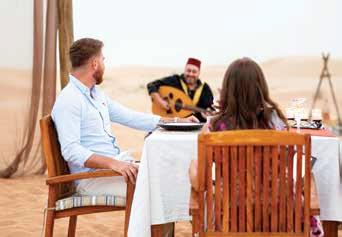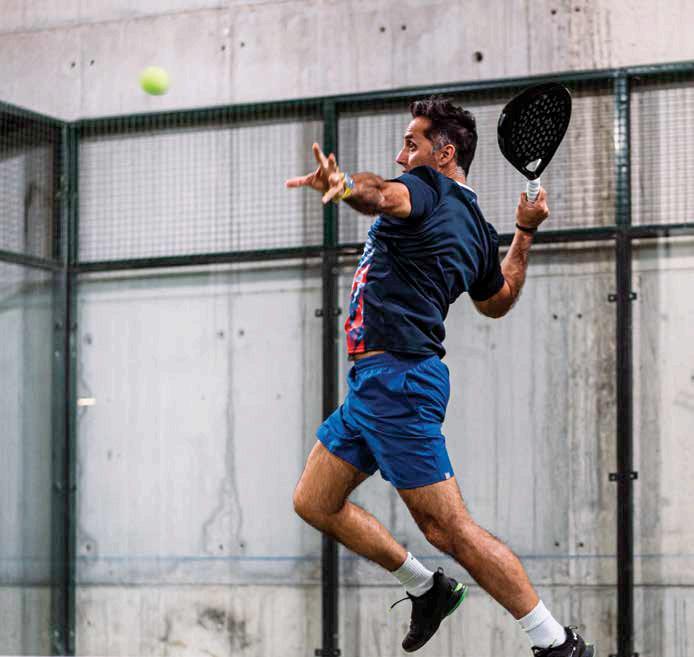
3 minute read
DESERT TOURS
SAND, SAFARI AND SUNDOWNERS
With the light slowly leaking from the sky, we deflate our tyres and enter the private reserve. Within a few minutes of winding down the windswept track, we have our first safari encounter. A group of wild oryx stand, unflinching, at the trackside, pale as sun-bleached bone. And Faisal is happy to play David Attenborough, dispensing fascinating nuggets of zoological trivia.
We pass by more oryx, handbag-sized mountain gazelle, and a couple of bashful sandfish. Our route through the DDCR cuts alongside ancient oases, and a surprising palette of nomad green — boutique samur forests, ghaf trees, and the occasional poisonous bloom of apple.
Our mechanical camel plods on, past playful groups of sand gazelle and circling falcons, until we reach our first designated checkpoint. We’re at the base of a broad dune, with nothing but undulating gold and flecks of emerald vegetation for miles in every direction.
Waiting for us, our waitress pours a tall cool flute of sparkling date juice (sparkling wine is available outside of Ramadan), and we’re led to a viewing encampment on the dune’s peak. Then we’re left, seated on Arabian-style plush cushions with the orchestral sounds of silence, a warm desert breeze and a watercolour sunset, Monet himself would feel proud to claim.
PRACTICALITY MAKES PERFECT
The next stop, just a short drive away, is our camp for the evening. We exit the Jeep barefoot, to earth ourselves in the experience, and walk between the two columns of tiki torches guiding the way to our secluded roofless restaurant.
The Perfect Evening is entirely private, the guest list comprises just you and your date. Our guide Faisal sets up the camp’s telescope for casual moon gazing, snaps a few photographic souvenirs on our phones, then bids us farewell.
Our waitress and bottomless bar (optional) lady notes down a drinks order, and leaves us to explore base camp. The central structure is a narrow wooden cabana, adorned with romantic lighting and billowing curtains, arching over a table laid out in established fine dining form.
We take up residence on the swing chairs next to a merrily-crackling fire pit and contemplate the harmony of contrasts in this space. It’s both utterly luxurious, and wholesomely natural, exciting yet calming. And it’s beginning to feel like that might be part of the recipe for ‘perfect’.

JUST DESERTS
There’s a range of three-course in-desert dining available, and we’ve selected fillet steak for the main course. Our package includes the serenading sounds of an oud player, and we can’t help but smile at the warm, gleeful audacity of it all. Toque’s off to our chef for creating a meal that could stand toe-to-toe with much of Dubai TripAdvisor’s trending top 20, all from the humble hub of a bedouin kitchen. Before we climb back into the Wrangler for the journey home, we offer one final salute to this most memorable occasion by clearing a four-man serving of sticky date pudding.
THE VERDICT
With a price tag of Dh3,999 for two (Dhs4,499 with unlimited alcohol), for most this won’t become a regular Friday thing. But that’s also, kind of the point. Perfect can’t happen every day. And this evening really does come close to being the perfect set-up for a special occasion. Available daily, yearround, with pick-ups anywhere in Dubai from around 4.30 to 5pm, priced from Dhs3,999 for two perople. Book direct on arabian-adventures. com website, and we highly recommend you ask for Faisal to be your guide.
Photo: Getty

New Balls Please
Padel is the new buzz word in fitness. Here’s the full lowdown on the tennis alternative and the best places to serve up a treat…
Move over Wimbledon, with your regular rackets and your old-school tennis courts, padel is the new kid on the block. Invented in 1969 in Mexico by Enrique Corcuera, padel was recognised as an international sport in September 2019 and is one of the world’s fastest growing sports by participation. Played predominately as a doubles game, it’s very similar to regular tennis with a bit of squash thrown in: the court is about 25 per cent smaller than a tennis court and enclosed in glass walls, which can also be utilised during play – and metal mesh fences that can’t. When it comes to keeping score, you go up 15, 30, 40 as usual. The serve is under arm, the racket is smaller and more of a flat bat, and the balls have a lower pressure. It’s often called padel tennis, which can be confusing as there’s another less-played sport called Paddle Tennis, which is similar but doesn’t use walls.



